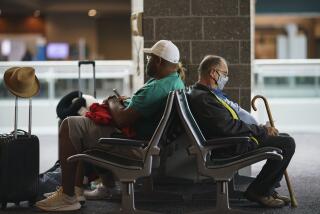Don’t let Grandma’s well-meaning pleas sabotage your diet
- Share via
Eating healthfully while on the road has never been a bigger challenge. Airline meals are mostly a memory, not that they were always nutritious, and airplane snack boxes often contain cookies and candy. Once you get to your destination, you may be facing your company’s five-course banquet or Grandma, who never met a carbohydrate or a fat gram she didn’t want to share with you.
Three dietitians share strategies for minimizing weight gain while traveling.
“Carry a water bottle, even though you can get it on the plane,” says Bettye Nowlin, a Calabasas dietitian and a spokeswoman for the American Dietetic Assn. Try to drink 8 ounces of water an hour, she advises, although she acknowledges that can be difficult. Limit alcohol to one drink per flight, because the calories add up quickly.
Take healthful foods on planes to keep from indulging in the snack packs loaded with sugar and fat. “Think Ziploc bags,” Nowlin says. In hers, she stows baby carrots, celery sticks, cherry tomatoes and jicama chunks. “Bananas keep and are filling,” she says.
Energy bars are a good choice, says Evelyn Tribole, an Irvine dietitian and author of “Eating on the Run.” “Look for ones with fiber, at least 3 grams per bar,” she says, because fiber is filling.
Along with carry-on snacks, an attitude shift is essential, says Anne Fletcher, a Minnesota dietitian and author of “Eating Thin for Life.” “I look on it as my eating habits [on the road] are no different than they are at home. If I know I am going to be gone for a while, I always take pretzels, frozen string cheese that might last 24 hours and fruit. I put them all in my carry-on.”
Before the trip, getting nutritional information can help you make wise choices -- like the labels on the airline snack boxes. Passengers booking on United and its low-fare Ted service can ask reservations agents about snack box descriptions. The Jumpstart, with Wheat Thins crackers, a granola bar, green tea and fruit packed in juice, beats out the Funpack, with a cookie bar, candy and Goldfish crackers.
If you need a meal at the airport and must depend on fast-food restaurants, a little planning on the Internet can help. For instance, McDonald’s recently posted on its website, www.mcdonalds.com, its best menu choices for calorie counters, carb counters, fat counters and those with diabetes.
What’s the strategy if you face tables laden with food or feel pressure from relatives to eat up? “First look around to see what they are serving,” Nowlin says. “Go for the vegetables and fruits first. Have the lean meats without the gravies.”
Dessert? “Try to get just a very small piece; take a bite or two,” she says.
And if Grandma says, “Try this,” Nowlin suggests saying, “That was delicious, but I am so full I can’t eat another bite. But I would love to have your recipe.”
Polite refusals are the key, Tribole says. “It looks so good, but I am so full.” This works only if you are consistent. “If you give in, you are giving mixed messages,” she says.
If the food pushers get too aggressive, Fletcher says it’s OK to get assertive. “People who have lost weight and kept it off do what they need to do to be successful,” she says. “If that means sticking diet dressing in their purse before going out to a restaurant, they will do that.”
Or you can borrow the retort of one woman, Fletcher says. When pushed to eat, she asked, “Why is it so important to you that I eat?”
Healthy Traveler appears every other week. Kathleen Doheny can be reached at kathleendoheny@earthlink.net.
More to Read
Sign up for The Wild
We’ll help you find the best places to hike, bike and run, as well as the perfect silent spots for meditation and yoga.
You may occasionally receive promotional content from the Los Angeles Times.






